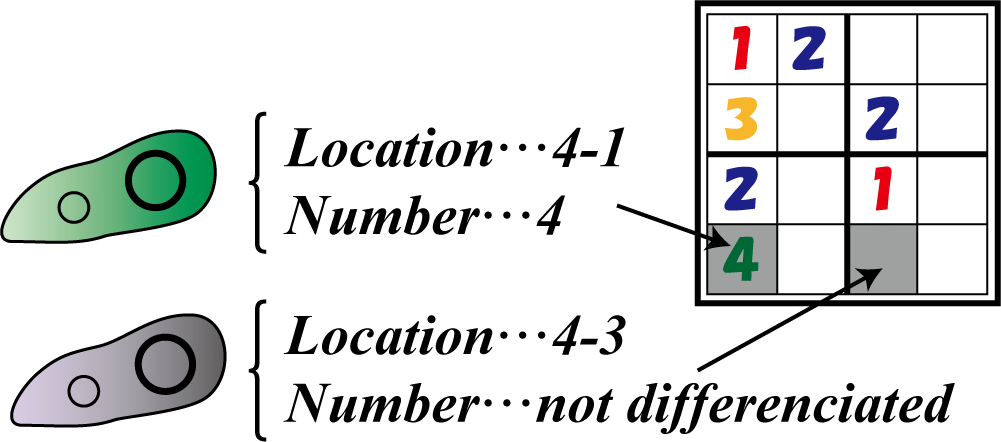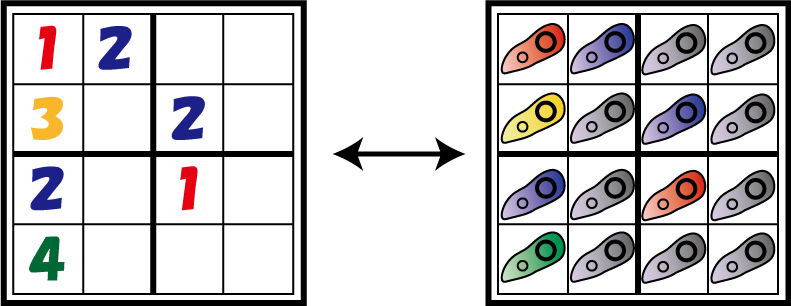Team:UT-Tokyo/Sudoku abstract
From 2010.igem.org
(→Abstract) |
|||
| Line 13: | Line 13: | ||
We're trying to make ''E.coli'' solve Sudoku puzzle. Human and Computers can solve Sudoku, of course. But ''E.coli'', which is lower animal, solves sudoku in our project. It is very very interesting! | We're trying to make ''E.coli'' solve Sudoku puzzle. Human and Computers can solve Sudoku, of course. But ''E.coli'', which is lower animal, solves sudoku in our project. It is very very interesting! | ||
| - | === What is Sudoku? === | + | ==='''What is Sudoku?'''=== |
[[Image:What_Sudoku_99.png|200px|thumb|What's Sudoku?]] | [[Image:What_Sudoku_99.png|200px|thumb|What's Sudoku?]] | ||
| - | Sudoku is a | + | Sudoku is a puzzle game with the objective of filling a 9x9 grid of cells with the numbers 1~9 without entering the same number in a column, row or “block (see figure).” |
| + | A player is given a grid in which some of the cells are filled in from the beginning and must complete filling in the grid by entering the remaining numbers. | ||
| - | ==='' | + | |
| + | ==='''Solution unique to the microbe: parallel computing'''=== | ||
[[Image:E.coli_info.png|200px|thumb|Each E.coli possesses two information]] | [[Image:E.coli_info.png|200px|thumb|Each E.coli possesses two information]] | ||
[[Image:Parallel_computing.png|200px|thumb|Every cells "consider" independently]] | [[Image:Parallel_computing.png|200px|thumb|Every cells "consider" independently]] | ||
| - | + | When we solve Sudoku, either manually or by using a calculator, we usually enter random numbers in the grid one by one and look for the correct combination by trial-and-error. On the other hand, our E. coli are each capable of independently filling in the boxes simultaneously. In other words, our E. coli perform parallel computing. | |
| - | |||
| - | + | ==='''How to solve Sudoku?'''=== | |
| - | ===''' | + | |
To solve Sudoku by human or the computer, we have to check the candidate of numbers which matches the rules for each 9x9 boxes. On the other hand, E. coli can fill in all boxes at a time by the system below.<br> | To solve Sudoku by human or the computer, we have to check the candidate of numbers which matches the rules for each 9x9 boxes. On the other hand, E. coli can fill in all boxes at a time by the system below.<br> | ||
-Judging all boxes simultaneously.<br> | -Judging all boxes simultaneously.<br> | ||
| Line 36: | Line 36: | ||
==='''Differentiation model in prokaryote'''=== | ==='''Differentiation model in prokaryote'''=== | ||
| - | E. coli | + | Instead of the traditional 9x9 grid of cells, we use E. coli possessing information of its location within the grid, in a liquid mixture. |
| + | At the beginning, most of the bacteria are not designated a number while some of them are designated as an initial condition. Through undesignated bacteria receive information from their environment, they are designated a number, causing them to “differentiate” into a state in which they emit viruses possessing information of the bacterium’s location and number. These viruses in turn collectively compel other bacteria to be designated a particular number. | ||
| - | + | In such a system, each bacterium must be able to identify relevant information, retain this information, and finally amass this information to “differentiate” into a particular number. | |
| - | + | To realize this, we use DNA recombination caused by proper virus. | |
| - | |||
| - | |||
| + | ==='''Differentiation model in prokaryote'''=== | ||
| + | E. coli in each box rearrange DNA and determine their numbers by receiving information about the number from other E. coli in the same row, column, and block. In other words, they change their states irreversibly from “the multi-output state” to “the uni-output state.” | ||
| + | |||
| + | We realize this by making a switch we named “4C3 leak switch,” using the leak of terminators. This switch turns on when three of four choices are transmitted, regardless of the order of transmission. | ||
| + | |||
| + | |||
| + | |||
| + | ==='''Information transmission by virus'''=== | ||
| + | To transmit information for proper E. coli, we use RNA phage named “signal virus.” Translation of the RNA transmitted from signal virus is controlled by antisense RNA characteristic to their location information. | ||
| + | |||
| + | This destination-restricted information diffusion can be a powerful tool for building bio-computer, which use the creature as the unit of calculation. | ||
== Appeal point == | == Appeal point == | ||
Revision as of 11:26, 14 September 2010
Sudoku
Abstract Construct Lab note Result
Abstract
We're trying to make E.coli solve Sudoku puzzle. Human and Computers can solve Sudoku, of course. But E.coli, which is lower animal, solves sudoku in our project. It is very very interesting!
What is Sudoku?
Sudoku is a puzzle game with the objective of filling a 9x9 grid of cells with the numbers 1~9 without entering the same number in a column, row or “block (see figure).” A player is given a grid in which some of the cells are filled in from the beginning and must complete filling in the grid by entering the remaining numbers.
Solution unique to the microbe: parallel computing
When we solve Sudoku, either manually or by using a calculator, we usually enter random numbers in the grid one by one and look for the correct combination by trial-and-error. On the other hand, our E. coli are each capable of independently filling in the boxes simultaneously. In other words, our E. coli perform parallel computing.
How to solve Sudoku?
To solve Sudoku by human or the computer, we have to check the candidate of numbers which matches the rules for each 9x9 boxes. On the other hand, E. coli can fill in all boxes at a time by the system below.
-Judging all boxes simultaneously.
-Getting information about the location. (Which boxes they are in?)
-Outputting the correct number.
In other words, we propose the possibility of the new method of calculation, parallel computing, which has never been realized by traditional computers.
Differentiation model in prokaryote
Instead of the traditional 9x9 grid of cells, we use E. coli possessing information of its location within the grid, in a liquid mixture.
At the beginning, most of the bacteria are not designated a number while some of them are designated as an initial condition. Through undesignated bacteria receive information from their environment, they are designated a number, causing them to “differentiate” into a state in which they emit viruses possessing information of the bacterium’s location and number. These viruses in turn collectively compel other bacteria to be designated a particular number.
In such a system, each bacterium must be able to identify relevant information, retain this information, and finally amass this information to “differentiate” into a particular number. To realize this, we use DNA recombination caused by proper virus.
Differentiation model in prokaryote
E. coli in each box rearrange DNA and determine their numbers by receiving information about the number from other E. coli in the same row, column, and block. In other words, they change their states irreversibly from “the multi-output state” to “the uni-output state.”
We realize this by making a switch we named “4C3 leak switch,” using the leak of terminators. This switch turns on when three of four choices are transmitted, regardless of the order of transmission.
Information transmission by virus
To transmit information for proper E. coli, we use RNA phage named “signal virus.” Translation of the RNA transmitted from signal virus is controlled by antisense RNA characteristic to their location information.
This destination-restricted information diffusion can be a powerful tool for building bio-computer, which use the creature as the unit of calculation.
Appeal point
Parallel computing
Our E.coli is superior to PC.
Differentiation model
This is a model of Eukarya differentiation model created by prokaryote.
Future vision
?????
 "
"


